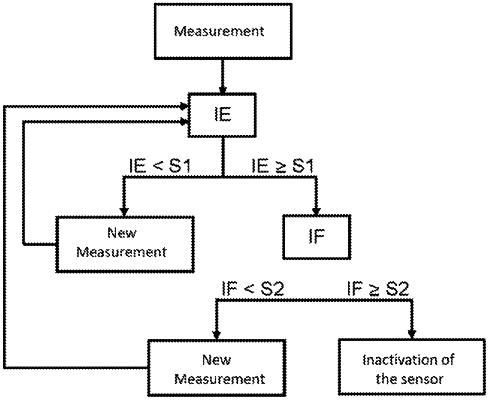| CPC G01N 33/007 (2013.01) | 14 Claims |

|
1. A method for determining a potential poisoning of a sensor of an electronic nose by a volatile compound following a nth exposure of the sensor to a gaseous sample comprising at least the volatile compound, n being an integer greater than or equal to 1, comprising at least the steps of:
a) eliminating the gaseous sample from the sensor after the exposure of the sensor to the gaseous sample;
b) measuring a baseline Bn of the sensor after eliminating the gaseous sample;
c) calculating a poisoning indicator IE via formula:
IE=(Bn−Bn-1)−(f×Un)
wherein:
Bn-1 is a baseline of the sensor before the exposure of the sensor to the gaseous sample;
Un is an amplitude of a signal emitted by the sensor during its exposure to the gaseous sample;
f is a weighting parameter; and
d) comparing the poisoning indicator IE thus calculated with a threshold value S1;
whereby:
if IE is less than the threshold value S1, then the sensor is not poisoned; and
if IE is greater than or equal to the threshold value S1, then the sensor is poisoned;
and further comprising, if IE is equal to or greater than the threshold value S1, the steps of:
e) calculating a functionality indicator IF of the sensor via formula:
 wherein:
B is a reference baseline;
p is a parameter representative of a working range of the sensor; and
f) comparing the functionality indicator IF thus calculated with a threshold value S2;
whereby:
if IF is less than the threshold value S2, then the sensor is still functional; and
if IF is greater than or equal to the threshold value S2, then the sensor is no longer functional.
|